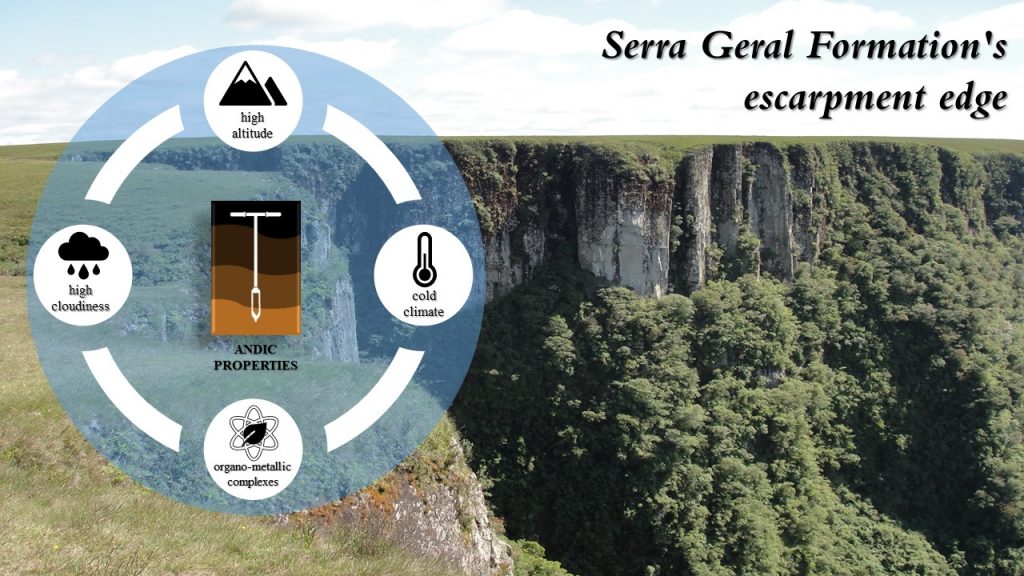Andic properties in soils with histic horizon “O” in the highlands of Southern Brazil
31/Mar/2021
ABSTRACT Soils with andic properties are characterized by a low apparent density, variable charges, large amounts of allophanes, imogolite, ferrihydrite, and/or organo-metallic complexes with Al, and present high phosphate retention. Soils derived from non-pyroclastic materials rich in silicates, formed under a cold and humid climate, a large amount of organic carbon, acid weathering, andic properties can manifest when a large amount of Al is present in the form of organo-metallic complexes. This study aimed to evaluate the characteristics and geographical […]
Analysis of Potential for Linear Erosion in the Cerrado Biome Using Morphopedology
12/Jun/2017
ABSTRACT The Cerrado is a vegetation complex with a wide variety of phytophysiognomies, and sustainable management is essential for maintaining biodiversity. Morphopedology is a tool that can assist in developing plans for control of soil and land use, especially in evaluating the potential of soil erosion processes. This technique allows landscape units considered “homogeneous” to be distinguished, as a result of interaction between physiographic conditions. The aim of this study was to evaluate potential for erosion in São Miguel do […]
Boundary between Soil and Saprolite in Alisols in the South of Brazil
01/May/2015
Despite numerous studies conducted on the lower limit of soil and its contact with saprolite layers, a great deal of work is left to standardize identification and annotation of these variables in the field. In shallow soils, the appropriately noting these limits or contacts is essential for determining their behavior and potential use. The aims of this study were to identify and define the field contact and/or transition zone between soil and saprolite in profiles of an Alisol derived from […]
Characterization and classification of soils with dark subsurface horizons derived from granite rocks in the Sul-Rio-Grandense Shield, Brazil
01/Aug/2014
Dark subsurface horizons with morphological characteristics similar to sombric horizons are found in higher altitude areas of the eastern portion of the Sul-Rio-Grandense Shield, Brazil. They developed in the A2, AB (or AC), and BA horizons of Ultisols, Alfisols, and Entisols. The mechanisms responsible for their genesis are still poorly understood, although most authors agree on the illuvial origin of the humus horizon and on its diagnostic character. The objective of this study was to characterize and analyze nine soil […]
Characterization of vertisols from the island of Fernando de Noronha, Pernambuco, Brazil
01/Aug/2014
The Archipelago of Fernando de Noronha (FN), Brazil, has poorly developed soils of the Cambisol, Vertisol, and Leptosol classes (WRB-FAO), with particular characteristics related to parent material of volcanic origin, a tropical climate with oceanic influence, and rolling to strongly rolling relief. The Vertisols of FN are formed from basic rocks, volcanic tuffs, and alluvial sediments. They are associated with depressed surfaces that have impeded drainage from the central highlands and coastal plains. In view of the need for environmental […]
Origin of sandstones from the Guará formation and their pedologic cover in Rio Grande do Sul, Brazil
01/Jun/2013
In the west and southwest regions of Rio Grande do Sul (RS) there are extensive areas with fragile soils developed from sandy sediments of the continental Mesozoic Paraná Basin. Inappropriate land use has accelerated the process of sandy desertification in these areas. In this case, the knowledge of soils is critical for the choice of appropriate management systems to regain sustainability. The objectives of this study were to understand the evolution and describe the relationships, in terms of origin, between […]
Hydraulic conductivity and water retention in leptosols-regosols and saprolite derived from sandstone, Brazil
01/Aug/2011
Leptosols and Regosols are soils with a series of restrictions for use, mainly related to the effective depth, which have been poorly studied in Brazil. These soils, when derived from sedimentary rocks should be treated with particular care to avoid environmental damage such as aquifer contamination. The purpose of this study was to verify the behavior of hydraulic conductivity and water retention capacity in profiles of Leptosols and Regosols derived from sandstone of the Caturrita formation in Rio Grande do […]
Integration of quickbird data and terrain attributes for digital soil mapping by artificial neural networks
01/Jun/2011
This study evaluated different environmental variables in the digital soil mapping of an area in the northern region of Minas Gerais State, using artificial neural networks. The environmental variables terrain attributes (slope and compound topographic index), the quickbird bands 1, 2 and 3, and lithology were evaluated. The importance of each of the variables in the classification was tested. The “Java Neural Network Simulator” was used with the backpropagation learning algorithm. For each dataset a neural network was created to […]
Morphology of soil-saprolite-rock contacts in neossolos derived from sandstone (caturrita formation) in Rio Grande do Sul, Brazil
01/Dec/2010
The use of the shallow Neossolos (Leptosols and Regosols) is limited in view of the small depth and rock fragments on the surface. There is a lack of information about the definition of the contacts between soil, saprolite and rock in this soil class, as well as tools that would facilitate the morphologic field identification. The objectives of this research were an evaluation of the morphology of the contact between soil, saprolite and rock in the Neossolos derived from the […]
Brazilian soil science: from its inception to the future, and beyond
01/Jun/2010
The present essay is meant to provide some background on the evolution of the soil science community in Brazil, since its inception, to describe its current situation, and to outline a number of opportunities and challenges facing the discipline in decades to come. The origin of Brazilian agronomy dates back to the beginning of the 19th century as a subdiscipline of botany, and its association with chemistry would later establish it as a science. In the middle of the 19th […]

